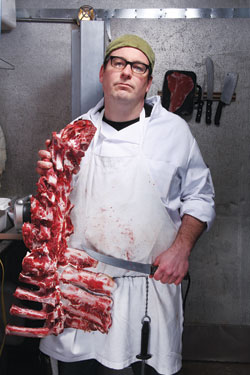
In the old days, every neighborhood had a friendly family-run butcher shop, a place where stout men in blood-streaked aprons would cut meat, dispense sage advice or a terse recipe, and indulge the pickiest old ladies’ requests with graceful aplomb. These men had the respect of their communities and the honor of their time-tested profession. What they didn’t have was a mob of slavering hipsters lined up to take a class on pig butchery, say, or restaurant clients that bandied their names about on menus as a selling point.
The brash new face of this modern carnivore movement is Tom Mylan, resident butcher at Williamsburg’s Marlow & Sons and guiding force behind Marlow & Daughters, the progressive butcher shop the owners of Marlow, Diner, and Bonita plan to open this month. The timing couldn’t be better: As a cursory glance at the bonanza of burger joints and steakhouses will tell you, New Yorkers aren’t eating less meat. We are, though, eating better meat, thanks in part to anti-factory-farm pundits like Michael Pollan. And to pioneers like Joshua and Jessica Applestone, the founders of the Hudson Valley’s trendsetting Fleisher’s, the original cult butcher among the ecofriendly crowd.
That’s where Mylan apprenticed to learn everything about the craft, from proper sourcing to the revolutionary (or at least resurrected) idea that to pay full respect to the slaughtered animal, and to minimize waste, all of its parts should find a place on the table. The nose-to-tail approach championed by chefs like Fergus Henderson has been gaining steam in restaurant kitchens, but at Marlow & Daughters, the city’s only whole-animal butcher shop and retail source of exclusively locally raised meat, Mylan aims to instill it in his clientele. “The intention is to educate people,” he says. “We want to teach them how to make something delicious out of something that’s weird.” He’s had a head start by demonstrating how to break down whole animals in the classes he teaches at Williamsburg’s Brooklyn Kitchen, the housewares shop, and on his unabashedly blustery blog, Tom the Butcher. But he’s not the only meat maven in town.
Venerable butcher shops like Pino’s and Florence have always had a devoted following, as has Lobel’s on the Upper East Side, which sells its pricey, pristine merchandise over the Web. But some of the savviest meat marketing of late has come out of the actual meat market, where wholesalers like Pat LaFrieda have practically become rock stars for the custom burger blends they sell to restaurants like Shake Shack and the Spotted Pig. (City Burger in midtown just added the coveted LaFrieda Black Label burger to its menu, generating a storm of blog buzz, and next year, Bloomingdale’s will open Flip, a burger shop that will carry a range of LaFrieda burger blends the way the men’s department carries a range of Calvin Klein underwear.) This meat doesn’t have the imprimatur of a Fleisher’s, say, with its Pollan-esque associations. But still, when members of the dining public start demanding a LaFrieda burger, or are willing to pay a little more for a Mylan-cut porterhouse at Diner than they would at Peter Luger right across the street, you know the balance of butcher power has shifted.